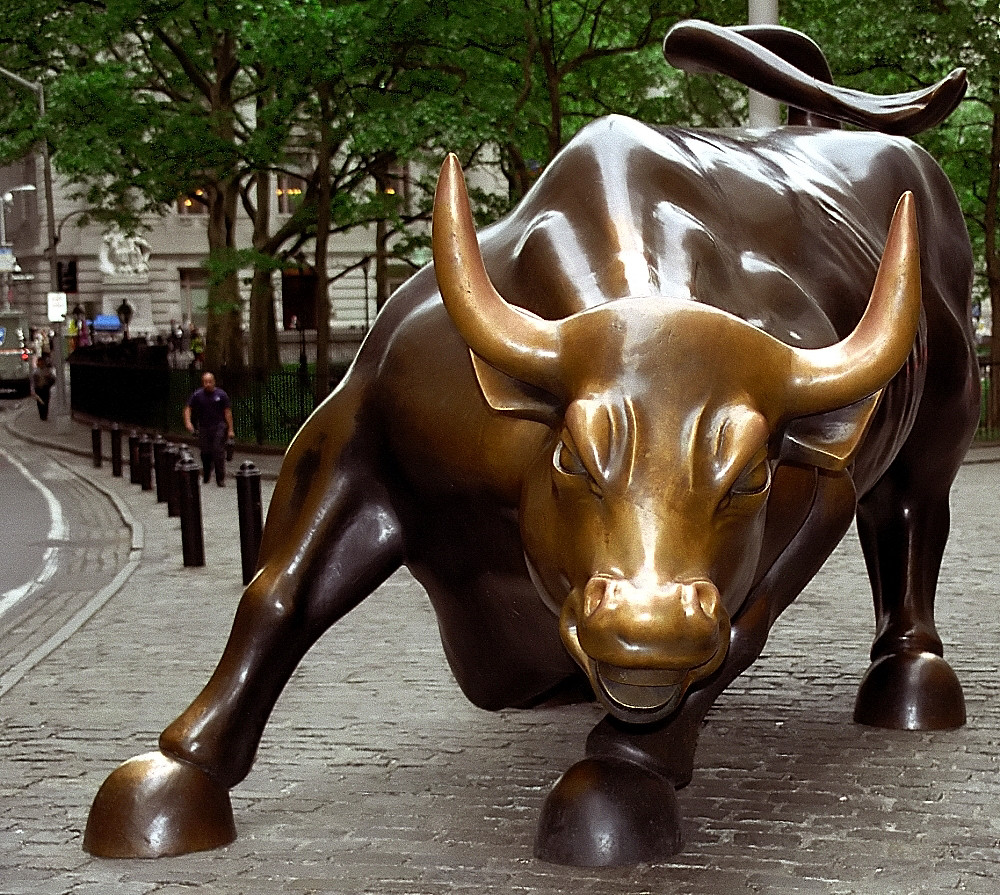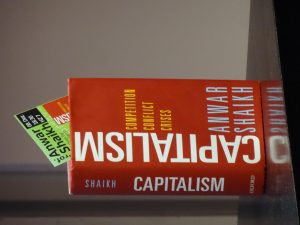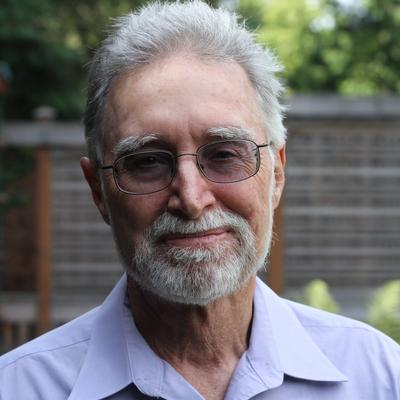Reading Marx’s Wage-Labour and Capital
✑ ALEX M. THOMAS` ╱ ± 6 minutes


Mainstream (marginalist) economics is built on a harmonious explanation of income distribution. In contrast, Marx argues that wages and profits are inversely related pointing to the fundamental conflict characterising income distribution in a capitalist society.

Marx intended his writings to be understood by the workers.

Mainstream (marginalist) economics is built on a harmonious explanation of income distribution. In contrast, Marx argues that wages and profits are inversely related pointing to the fundamental conflict characterising income distribution in a capitalist society.
From: Alex Thomas, Sep 15 2018. ╱ About the author
Alex M. Thomas is Assistant Professor of Economics at Azim Premji
University, India. He both teaches and researches in the area of History of
Economic Thought. Besides publishing articles in journals such as the History of Economic Ideas and History of Economics Review, he
writes blog posts
occasionally. On twitter: @alexmthomas.
This post critically engages with Wage-Labour and Capital (available
freely at
Marxists.org
), which were originally lectures, and later published as a set of articles
in 1849 in the Neue Rheinische Zeitung (which roughly translates
into the ‘New Rhenish Newspaper’). Marx had delivered the lectures at the
German Working Men’s Club of Brussels in 1847, a year before the
publication of the Communist Manifesto and twenty years before the
publication of Das Kapital.
Wage-Labour and Capital is made up of 9 short chapters, with the largest chapter containing 5 pages, and a total of 48 pages. In the introduction, F. Engels provides his reasons for altering the original text of Marx, and writes “this pamphlet is not as Marx wrote it in 1849, but approximately as Marx would have written it in 1891” (p. 6). To assess the merits of Engel’s editorial intervention, one needs to compare it with Marx’s original. Marx intended his writings to be understood by the workers and therefore they do not “presuppose a knowledge of even the most elementary notions of political economy” (p. 16).
In capitalism, according to Marx, “it appears that the capitalist buys their labour with money, and that for money they sell him their labour. But this is merely an illusion. What they actually sell to the capitalist for money is their labour-power” (p. 17). Therefore, labour-power “is a commodity, no more, no less so than is the sugar. The first is measured by the clock, the other by the scales” (p. 17). And wages is the “special name for the price of labour-power”, a “peculiar commodity”. The wage-workers, who owns labour-power, does not really have a choice in deciding whether to sell it to the capitalist or not, but is forced to “in order to live” (p. 19). While it appears that the worker has a choice, in essence, she does not (this idea can help transform the dominant labour-leisure trade-off story). Then Marx points out that this feature – the idea of free labour – is particular to capitalism, and not found in slave or feudal societies. While the worker owns labour-power, the capitalist owns “raw materials, tools, and means of life” (p. 20). The following description of work (and life) deserves to be quoted in full.
Most economists define capital as produced means of production, and this is the starting point of their analysis. But Marx pushes the starting point further and rightly labels capital as “accumulated labour”, as the raw materials, instruments, and machines were also created by labour. Capital is also a “social relation of production” (p. 29). As noted earlier, the existence of wage labour is a characteristic of capitalism where workers are forced to sell their labour power to the capitalist in order to live. And as Marx writes, “The existence of a class which possesses nothing but the ability to work is a necessary presupposition of capital” (p. 30). Furthermore, capital, or accumulated labour dominates living labour.
Mainstream (marginalist) economics is built on the marginal productivity theory of distribution which states that under conditions of perfect competition, in equilibrium, workers are paid the marginal product of capital and capitalists get the marginal product of capital – a harmonious explanation of income distribution. In contrast, Marx argues that wages and profits are inversely related pointing to the fundamental conflict characterising income distribution in a capitalist society (p. 37). In the same chapter (VII), Marx outlines two major routes through which profits increase: (1) increase in aggregate demand and (2) technological improvements (see an earlier post on the link between demand, profits, and employment). In the following chapter, Marx reiterates the distributional conflict: “the interests of capitals and the interests of wage-labour are diametrically opposed to each other” (p. 39). And “If capital grows rapidly, wages may rise, but the profit of capital rises disproportionately faster. The material position of the worker has improved, but at the cost of his social position. The social chasm that separates him from the capitalist has widened” (p. 40). This underscores the social nature of economic relations, an aspect which marginalist economics has eschewed with its assumption of the independence of individual preferences.
The following remark about economists by Marx is appropriate for our current times: “The economists tell us, to be sure, that those labourers who have been rendered superfluous by machinery find new venues of employment” (p. 45). I shall end this post by quoting Marx on capitalist accumulation, crises, and exploitation of markets, since it continues to remain relevant today.
Wage-Labour and Capital is made up of 9 short chapters, with the largest chapter containing 5 pages, and a total of 48 pages. In the introduction, F. Engels provides his reasons for altering the original text of Marx, and writes “this pamphlet is not as Marx wrote it in 1849, but approximately as Marx would have written it in 1891” (p. 6). To assess the merits of Engel’s editorial intervention, one needs to compare it with Marx’s original. Marx intended his writings to be understood by the workers and therefore they do not “presuppose a knowledge of even the most elementary notions of political economy” (p. 16).
In capitalism, according to Marx, “it appears that the capitalist buys their labour with money, and that for money they sell him their labour. But this is merely an illusion. What they actually sell to the capitalist for money is their labour-power” (p. 17). Therefore, labour-power “is a commodity, no more, no less so than is the sugar. The first is measured by the clock, the other by the scales” (p. 17). And wages is the “special name for the price of labour-power”, a “peculiar commodity”. The wage-workers, who owns labour-power, does not really have a choice in deciding whether to sell it to the capitalist or not, but is forced to “in order to live” (p. 19). While it appears that the worker has a choice, in essence, she does not (this idea can help transform the dominant labour-leisure trade-off story). Then Marx points out that this feature – the idea of free labour – is particular to capitalism, and not found in slave or feudal societies. While the worker owns labour-power, the capitalist owns “raw materials, tools, and means of life” (p. 20). The following description of work (and life) deserves to be quoted in full.
"Life for him begins where this activity [work] ceases, at the table, at
the tavern, in bed. The 12 hours’ work, on the other hand, has no
meaning for him as weaving, spinning, boring, and so on, but only as
earnings, which enable him to sit down at a table, to take his seat in
the tavern, and to lie down in a bed.” (p. 19)
Subsequently, Marx discusses the determination of commodity prices, which
contains an account of competition. The latter is studied in three parts:
“among the sellers”, “among the buyers”, and “between the buyers and the
sellers” (p. 21). It is this competition which seeks the highest “customary
profits” among the different sectors, and this constant “immigration” (p.
23) tends to equalise the rate of profits across sectors. This force of
competition also tends to bring the actual price of a commodity close to
its “cost of production” (p. 24). The “fluctuations” occasioned by
competition is not an “accident” or exception but the “law” contrary to the
accounts of the “bourgeois economists” (p. 24). Thus, “In the totality of
this disorderly movement is to be found its order” (p. 24).
As Marx writes, “The existence of a class which possesses nothing but the ability to work is a necessary presupposition of capital” (p. 30)Wages are regulated by the cost of production of labour-power, which “is the cost required for the maintenance of the labourer as a labourer, and for his education and training as a labourer” (p. 26). In other words, it is “the cost of the existence and propagation of the worker” (p. 27). Here, Marx is referring to the wages for the entire class of workers and not of an individual worker because “millions of workers, do not receive enough to be able to exist and to propagate themselves” (p. 27).
Most economists define capital as produced means of production, and this is the starting point of their analysis. But Marx pushes the starting point further and rightly labels capital as “accumulated labour”, as the raw materials, instruments, and machines were also created by labour. Capital is also a “social relation of production” (p. 29). As noted earlier, the existence of wage labour is a characteristic of capitalism where workers are forced to sell their labour power to the capitalist in order to live. And as Marx writes, “The existence of a class which possesses nothing but the ability to work is a necessary presupposition of capital” (p. 30). Furthermore, capital, or accumulated labour dominates living labour.
Mainstream (marginalist) economics is built on the marginal productivity theory of distribution which states that under conditions of perfect competition, in equilibrium, workers are paid the marginal product of capital and capitalists get the marginal product of capital – a harmonious explanation of income distribution. In contrast, Marx argues that wages and profits are inversely related pointing to the fundamental conflict characterising income distribution in a capitalist society (p. 37). In the same chapter (VII), Marx outlines two major routes through which profits increase: (1) increase in aggregate demand and (2) technological improvements (see an earlier post on the link between demand, profits, and employment). In the following chapter, Marx reiterates the distributional conflict: “the interests of capitals and the interests of wage-labour are diametrically opposed to each other” (p. 39). And “If capital grows rapidly, wages may rise, but the profit of capital rises disproportionately faster. The material position of the worker has improved, but at the cost of his social position. The social chasm that separates him from the capitalist has widened” (p. 40). This underscores the social nature of economic relations, an aspect which marginalist economics has eschewed with its assumption of the independence of individual preferences.
The following remark about economists by Marx is appropriate for our current times: “The economists tell us, to be sure, that those labourers who have been rendered superfluous by machinery find new venues of employment” (p. 45). I shall end this post by quoting Marx on capitalist accumulation, crises, and exploitation of markets, since it continues to remain relevant today.
"capitalists are compelled … to exploit the already existing gigantic
means of production on an ever-increasing scale, and for this purpose
to set in motion all the mainsprings of credit, in the same measure do
they increase the industrial earthquakes, in the midst of which the
commercial world can preserve itself only by sacrificing a portion of
its wealth, its products, and even its forces of production, to the
gods of the lower world – in short, the crises increase. They become
more frequent and more violent, if for no other reason, than for this
alone, that in the same measure in which the mass of products grows,
and therefore the needs for extensive markets, in the same measure does
the world market shrink ever more, and ever fewer markets remain to be
exploited, since every previous crisis has subjected to the commerce of
the world a hitherto unconquered or but superficially exploited market”
(pp. 47-8)
| Top image: "The daily job" , by Erik Pevernagie, oil on canvas, 100 x 130 cm. From: Wikimedia |
|---|






















Comments
Post a Comment
Your thoughts...